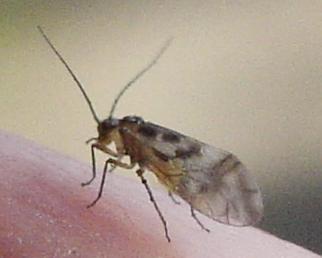Psocoptera

Psocoptera are an order of insects that are commonly known as booklice, barklice or barkflies.[1] They first appeared in the Permian period, 295–248 million years ago. They are often regarded as the most primitive of the hemipteroids.[2] Their name originates from the Greek word ψῶχος, psokhos meaning gnawed or rubbed and πτερά, ptera meaning wings.[3] There are more than 5,500 species in 41 families in three suborders. Many of these species have only been described in recent years.[4]
They range in size from 1–10 millimetres (0.04–0.4 in) in length.
The species known as booklice received their common name because they are commonly found amongst old books—they feed upon the paste used in binding. The barklice are found on trees, feeding on algae and lichen. No member of this order is currently considered endangered; in fact, in 2007, Atlantopsocus adustus, a species native to Madeira and the Canary Islands, was found to have colonized the mild Cornish coast of southwest England.[5]
In the 2000s, morphological and molecular evidence has shown that the parasitic lice (Phthiraptera) evolved from within the psocopteran suborder Troctomorpha.[6][7] In modern systematics, Psocoptera and Phthiraptera are therefore treated together in the order Psocodea.[8]
Psocids are small, scavenging insects with a relatively generalized body plan. They feed primarily on fungi, algae, lichen, and organic detritus in nature but are also known to feed on starch-based household items like grains, wallpaper glue and book bindings.[9] They have chewing mandibles, and the central lobe of the maxilla is modified into a slender rod. This rod is used to brace the insect while it scrapes up detritus with its mandibles. They also have a swollen forehead, large compound eyes, and three ocelli. Their bodies are soft with a segmented abdomen.[10] Some species can spin silk from glands in their mouth.[11] They may festoon large sections of trunk and branches in dense swathes of silk.[12]
Some psocids have small ovipositors that are up to 1.5 times as long as the hindwings, and all four wings have a relatively simple venation pattern, with few cross-veins. The wings, if present, are held tent-like over the body.[10] The legs are slender and adapted for jumping, rather than gripping, as in the true lice. The abdomen has nine segments, and no cerci.[11]
There is often considerable variation in the appearance of individuals within the same species. Many have no wings or ovipositors, and may have a different shape to the thorax. Other, more subtle, variations are also known, such as changes to the development of the setae. The significance of such changes is uncertain, but their function appears to be different from similar variations in, for example, aphids. Like aphids, however, many psocids are parthenogenic, and the presence of males may even vary between different races of the same species.[11]
